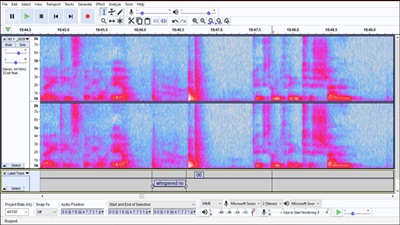Evp stands for Electronic Voice Phenomena
Evp stands for electronic voice phenomena and are voices captured on audio recordings that were not heard at the time and therefore only heard on playback that are thought to be that of spirits. A lot of recording devices can record frequencies as low as 7 hz and as high as 50,000Hz, however, some voice phenomena are sometimes heard by ear in real-time and are known as DVP: direct voice phenomena.
The father of capturing EVP is believed to be Fredrich Jurgenson who stumbled across it by accident while in a forest hut with the intention of recording birds singing. On review of a recording of a chirping Finch to his astonishment had also captured a trumpet solo of which he had no recollection of having heard such a clear loud noise at the time. Intrigued, he continued to record and then one day he recorded a message from his deceased mother, her voice calling him ‘Fridal’, her pet name for him. On many occasions the name of team members being spoken by unidentified voices has been recorded.
Sceptics theorise EVP to be nothing more than the bouncing of radio waves on the Ionis sphere creating evp but when a voice is captured that responds directly to either what is happening or a question/conversation then this is in itself more evidential of an intelligent response as opposed to some random radio bounce back in addition why would radio bounce back only consist of speech, why not music?
During one investigation a female investigator experienced growing anger towards another colleague, so much so she was concerned as the intensity grew, she could lash out. On review of the audio file, we had captured a male voice, with a northern accent that spoke out aggressively as Sallyann spoke "listen to her, gobbin" and threatened “this needs slapping”. To clearly hear what is said, it is usually best to use headphones, etc when listening to EVP to better single out voices other than that of the team.
Considering this theory and this occurrence one must consider the likelihood of being able to capture radio bounce back at that precise moment, using those particular words in a threatening manner at a time when someone is experiencing increasing anger and anger towards another person. Radio bounce back can be easily eliminated by placing the recording device in a Faraday bag/cage which will prevent radio waves being captured. A simple experiment is to use two recording devices next to each other, one in a Faraday bag the other placed next to it as normal and compare results.
Many scientists and parapsychologists disregard EVP as evidence, claiming that it is nothing more than sound pareidolia and at best a pseudoscience. With that said, one must be aware of sound matrixing and mistaking sounds for words. E.g., flowing water can sound like whispering, a squeak of a door, the rubbing of a coat sleeve can easily be mistaken for the spoken word or whistle. Nevertheless, having taken the latter into account what explanation is there for a voice that is captured on a recording that responds to teams’ conversations or activities, that was not heard at the time, or indeed voices that were. It must be noted that evps do have their own vocal tones, accents, inflections, etc just as the same variants of vocal differences of the living and can be discounted as not belonging to the team. Age brackets can also be established from the sound of a voice for examples are the voices of young children captured, their particular use of words like Mummy or Daddy, or general speech in the dead of night when there are no children around or a man’s voice is captured in the audio of an all-female group.
To understand more, let’s have a look at what is sound. sound is heard using frequency, decibels, and volume. People hear sounds the lowest frequency of 20Hz and the highest at 20,000 Hz. We hear best within 1,000-5000Hz which is where human speech is centred.
Frequency is the measurement of vibrations. Vibrations per second is measured units called hertz.
INFRA-sounds is the smallest range is 0 – 20Hz and is heard by Elephants and used for communication. Sounds above 20.000 Hz- as those used by animals- are called ULTRA-sound. Cats and Dogs hear frequencies of about 40 Hz – 60,000Hz, bats, whales, dolphins can hear up to 160,000 Hz.
Apart from frequencies sound is heard in Decibels which is the unit used to measure the intensity of sound. This can be affected by distance. Near total silence is 0 Db, normal conversation is 60 Db and lastly volume is a factor.

A spectrogram is a visual way of representing the signal strength, or “loudness”, of a signal over time at various frequencies present in a particular waveform. The X axis is read left to right and present time. The Y axis presents bottom; low pitch, to top; high pitch.
